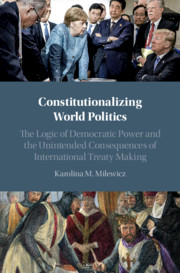 Constitutionalizing World Politics
Constitutionalizing World Politics Book contents
- Constitutionalizing World Politics
- Constitutionalizing World Politics
- Copyright page
- Dedication
- Contents
- Figures
- Tables
- Acknowledgments
- Abbreviations
- 1 Constitutionalization of World Politics – Seriously?
- Part I Constitutional Foundations
- 2 Constitutional Elements
- 3 National Constitutionalization
- 4 International Constitutionalization
- Part II The Logic of Democratic Power in Treaty Making
- Book part
- Bibliography
- Index
2 - Constitutional Elements
from Part I - Constitutional Foundations
Published online by Cambridge University Press: 21 July 2020
- Constitutionalizing World Politics
- Constitutionalizing World Politics
- Copyright page
- Dedication
- Contents
- Figures
- Tables
- Acknowledgments
- Abbreviations
- 1 Constitutionalization of World Politics – Seriously?
- Part I Constitutional Foundations
- 2 Constitutional Elements
- 3 National Constitutionalization
- 4 International Constitutionalization
- Part II The Logic of Democratic Power in Treaty Making
- Book part
- Bibliography
- Index
Summary
Chapter 2 conceptualizes constitutional properties in both domestic and international settings. Drawing on domestic experiences, it defines constitutions, whether written or unwritten, as a special category of institutions that provide fundamental rules (of recognition and change) as well as rules that regulate a community of members, their relations, and their rights and duties (rules of conduct). It then identifies corresponding constitutional properties in the international setting, acknowledging the limits of this analogy. While still embryonic, international rules with constitutional relevance are especially apparent in those binding treaties of public international law that are universal in intended participation, global in scope, and of substantive importance. These rules are underpinned by the principle of sovereignty, which provides for their stability and superiority. International constitutional rules define states as the prime members, organize inter–state relations in an anarchical environment by concentrating authority in circumscribed domains, and lay out rights and duties that enable collective action and set standards of appropriate behavior.
Keywords
- Type
- Chapter
- Information
- Constitutionalizing World PoliticsThe Logic of Democratic Power and the Unintended Consequences of International Treaty Making, pp. 25 - 77Publisher: Cambridge University PressPrint publication year: 2020


